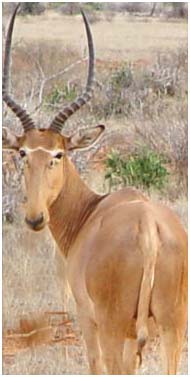Hunter antelope
| Hunter antelope | ||||||||||||
|---|---|---|---|---|---|---|---|---|---|---|---|---|

Hunter antelope ( Beatragus hunteri ) |
||||||||||||
| Systematics | ||||||||||||
|
||||||||||||
| Scientific name of the genus | ||||||||||||
| Beatragus | ||||||||||||
| Heller , 1912 | ||||||||||||
| Scientific name of the species | ||||||||||||
| Beatragus hunteri | ||||||||||||
| ( Sclater , 1889) |
The hunter antelope ( Beatragus hunteri , syn .: Damaliscus hunteri ) is one of the rarer antelopes in East Africa . It belongs to the hartebeest group (Alcelaphini). In the past it was regarded as a subspecies of the lyre antelope , today it is mostly classified as a separate species because of the wider display of horns. The zoologist Philip Lutley Sclater honored the English big game hunter Henry Charles Vicars Hunter (1861-1934) with the name .
The IUCN classifies the hunter antelope as critically endangered . Food competition with domestic cattle is a major reason for the decline in numbers.
Appearance
With a shoulder height of 100 cm, it corresponds in appearance to other red hartebeest, but is more delicately built. It can weigh up to 73 kilograms. The horns are up to 70 centimeters long. The coat is yellow-brown, has a white stripe between the eyes, and the tail is partially white. The horns differ from the other hartebeest, because they lack the typical wide helmet. The horn can rather be compared to the impala .
Distribution area and way of life
The hunter antelope occurs only in a very small distribution area of around 8000 km² near the coast in the border area between Kenya and Somalia. Other hartebeest, which are obviously food competitors with this species, are missing here. A small group was also introduced in Tsavo East National Park . The hunter antelope lives in herds of up to 25 animals. It prefers open steppes interspersed with bushes .
Danger
The IUCN classifies the hunter antelope as critically endangered . In the 1970s the population was estimated at 15,000 animals, but has fallen dramatically to below 250 since the 1980s (IUCN estimate 2016). Droughts, poaching and the displacement by cattle are the causes of the decline.
useful information
Other names for this animal include Hirola, a native name, and four-eyed antelope because of the dark pre-eye glands that appear like a second pair of eyes.
literature
- CA Spinage: The Natural History of Antelopes . Croom Helm, London 1986, ISBN 0-7099-4441-1
- Gabrielle E. Ruso: Beatragus hunteri (Artiodactyla: Bovidae). Mammalian Species 49 (955), December 8, 2017; Pp. 119-127. doi : 10.1093 / mspecies / sex015
Single receipts
- ^ Spinage, p. 186
- ^ Thomas M. Butynski: Beatragus hunteri Hirola. In: Jonathan Kingdon, David Happold, Michael Hoffmann, Thomas Butynski, Meredith Happold and Jan Kalina (eds.): Mammals of Africa Volume VI. Pigs, Hippopotamuses, Chevrotain, Giraffes, Deer and Bovids. Bloomsbury, London, 2013, pp. 490-495
Web link
- Beatragus hunteri inthe IUCN Red List of Threatened Species 2013.2. Listed by: IUCN SSC Antelope Specialist Group, 2008. Retrieved December 29, 2013.
